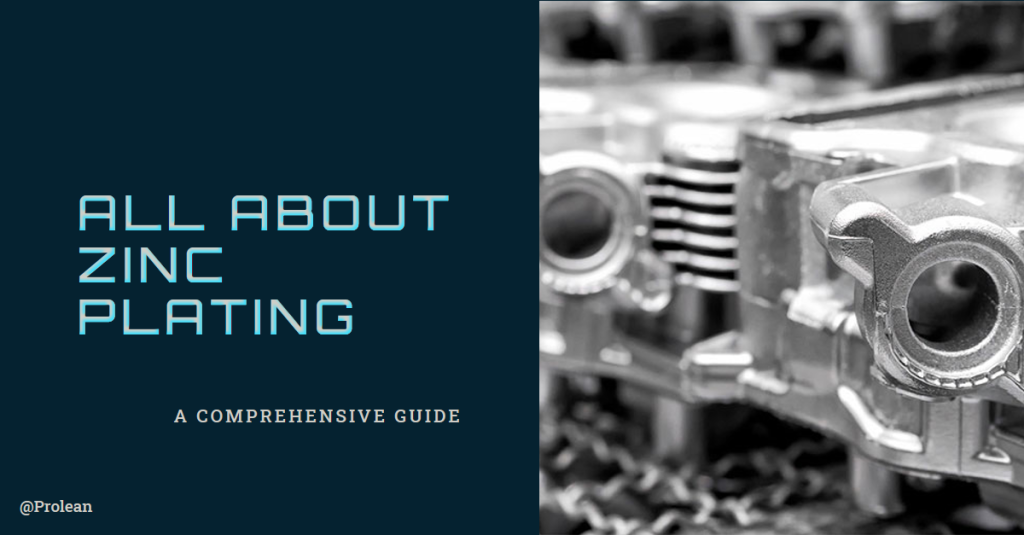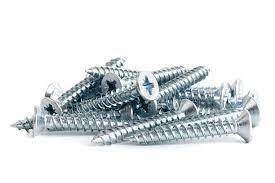“Rust, the metal’s worst enemy, emerges from the interaction of ferrous metal molecules with moisture, leading to degradation and failure of mechanical parts. Zinc plating addresses this by creating a corrosion-resistant barrier, enhancing not just the aesthetics but also the durability of products”

Have you seen anything on the metal’s surface that is orange-brown? It is referred to as rust, the metal’s worst enemy, and results from the reaction of ferrous metal molecules with moisture. Rust causes material degradation and ultimately contributes to the failure of products and mechanical parts. Zinc plating is used to tackle the rust formation problem by creating a thin barrier on the surface, preventing it from corrosion while reacting with the environment.
In this article, we will go through the working of zinc plating, the steps involved, affecting factors applications, advantages, and limitations.
What is Zinc Plating?
One surface finishing method for ferrous material components and products is zinc plating. It entails adding a thin layer to the surface without compromising dimensional stability, leaving a smooth, dull gray surface. Zinc plating gives an excellent aesthetic appeal to the products, but more than that, it makes products corrosion-resistant. The zinc plating process creates a thin protective coating by electrodepositing zinc on the metal that will be coated, also referred to as the substrate material.
How does Zinc plating work?
When zinc plating is exposed to air, it reacts with oxygen like ferrous metals do and produces zinc oxide (ZnO), which then combines with water to create zinc hydroxide ( ZnoH).
The twist comes now when atmospheric carbon dioxide and zinc oxide combine to form a thin layer of zinc carbonate (ZnCO3) that attaches to the underlying zinc and further shields it from corrosion.
Try Prolean Now!
Steps Involved in Zinc Plating
Step 1: Cleaning of surface
The first step in zinc plating is cleaning the surface to be plated to remove dust, oils, and rust so that surface will be coated with zinc effectively. For cleaning, alkaline detergents are the best agents that will not degrade the surface. However, acid cleaning can be applied before using alkaline detergents.
A bath between 100 and 180 degrees C helps to remove the grime before using an alkaline detergent for micro-level cleaning. After cleaning with an alkaline detergent, rinse the area immediately with distilled water to avoid damaging the material’s primary surface, which alkaline solutions can harm. If the surface cleaning is not carried out correctly, It might cause the Zinc coating to peel or become damaged.
Step 2: Pickling
Numerous oxides, including rust that has already formed, may be on the surface. Therefore, it is crucial to use acid solutions to remove these oxides and scales before proceeding with the zinc plating. The two most typical solutions employed in this process are sulfuric and hydrochloric acid. Products are submerged in this acid solution. The dipping time, temperature, and Concentration of acids depend upon the metal type and the scales’ thickness.
Following pickling by dipping the components in an acid solution, immediately clean with distilled water to avoid any violent reaction and degrading the surface.
Step 3: Preparation of plating bath
The next step is preparing the electrolytic solution for the electroplating process, also known as a plating bath. The bath is an ionic zinc solution that aids in streamlining the plating processes. It can be either acid zinc or alkaline zinc;
- Acid zinc: High efficiency, fast deposition, excellent covering power, but poor throwing power and weak thickness distribution.
- Alkaline zinc: Excellent thickness distribution with superior throwing power, but less plating efficiency, lower electro-deposition rate,
Step 4: Electrolysis Setup & Introducing the current

Zinc-plating setup
The actual deposition process starts with introducing the electric current (DC) after selecting the electrolyte depending on the product requirements and specifications. Zinc serves as the anode and is coupled to the substrate’s negative terminal (cathode). Zinc ions connect to the cathode (Substrate) as an electric current flows through the electrolytes, forming a thin barrier layer of zinc on the surface.
Additionally, there are two methods for electrolysis: rack plating and barrel plating (Rack and barrel plating).
- Racks: The substrate is dipped into the electrolyte while attached to the rack, Appropriate for large parts
- Barrel: The substrate is placed in the barrel and then rotated to get a uniform plating.
Step 5: Post-processing
To get rid of any potential contamination on the surface, parts must be cleaned with distilled water several times after the plating is finished. Before sending the plated products for storage after washing, they must be dried. If necessary, passivates and sealants can also be employed based on the required standards for surface finishing.
Factors to be considered
Knowing the factor will help to regulate the process and acquire optimal plating. Many factors affect the result of plating on the substrate.
Current density
The zinc layer thickness, which needs to be deposited on the substrate surface, is affected by the density of the current passing through the electrodes. Therefore, a Higher Current will create a thicker layer while a lower current will make a thinner layer.
The temperature of a plating bath
Another factor that influences zinc plating is the temperature of the electrolysis solution ( Plating bath). If the temperature is higher cathode consumes fewer hydrogen ions from the solution while at the same time taking more brighteners so that the zinc plating will be brighter due to the higher deposition of metallic crystal of zinc.
The Concentration of zinc in the plating bath
The zinc concentration in the plating bath also impacts the plating’s texture and degree of brightness. For example, a relatively rough surface will result from a high concentration because zinc ions will be distributed unevenly and deposit quickly. On the other hand, a Low concentration will result in brighter plating because fine crystals will be deposited slowly.
Other factors include the position of the Electrodes (anode & cathode), the substrate’s surface quality, the Concentration of surfactants and brighteners in the plating bath, contaminations, and more.
Try Prolean Now!
Advantages of Zinc Plating
In addition to preventing rust, zinc plating has several other benefits; let’s go over a few with a short description.
- Low-cost: It is the cost-effective method of surface finishing compared to other methods, including powder coating, black oxide finishing, and silver plating.
- Strengthen: The zinc coating on ferrous metals, copper, brass, and other substrates helps to increase the strength of those materials.
- Dimensional stability: Adding a zinc layer won’t affect the components’ or products’ dimensional stability,
- Aesthetic beauty: After plating, the substrate surface will appear glossy and appealing, and colors can be added post-processing.
- Ductility: Because zinc is a ductile metal, shaping the underlying substrate is made simple.
Limitation of Zinc Plating
Zinc plating is a cost-effective and environmentally friendly process for rust prevention on products and components made with iron, steel, copper, brass, and other similar materials. However, it is unsuitable for petroleum, pharmaceutical, aerospace, and food products, such as frequently immersed in the solutions.
Zinc Plating Applications

Zinc Plated Threads
Hardware
Zinc plating plays a significant part in maintaining the joints for an extended period. Screws, nuts, bolts, and other fasteners have zinc plating on them to prevent rusting, which could lead to failure.
Automotive Industry
Zinc plating makes the parts corrosion-resistant. Brake pipes, calipers, bases, and steering components are zinc-plated.
Plumbing
Because plumbing materials constantly interact with water, rusting is the most significant problem when working with them. Steel piping durability has been revolutionized by zinc plating. Zinc-plated pipes have a 65+ year lifespan.
Military
Tanks, armored personnel carriers, vehicles, and other military equipment use zinc plating.
Conclusion
Zinc plating is a complex surface finishing process that requires expert engineers & operators with specialized advanced types of equipment.
we have been offering manufacturing services under one roof, from prototype design to product finishing. Using Zinc plating technology, we have been providing high-quality surface finishing services for products and parts from our expert engineers with decades of industry experience. Please do not hesitate to contact us if you need any further services related to Zinc plating.
FAQ’s
What is zinc plating?
Zinc plating is one of the prominent surface finishing approaches, in which a thin layer of zinc is applied on the surface of products to make them excellent corrosion-resistive.
Is zinc plating can only be applied on ferrous metal and alloys?
No, Zinc plating is applicable for more than ferrous metals and alloys such as copper & brass.
What are the factors that affect the zinc plating process?
Several factors affect the results of zinc plating, such as Current density, zinc concentration on the plating bath, temperature, electrode positions, and more.
What are the steps involved in zinc plating?
Cleaning of the products, pickling, preparation of plating bath, electrolysis, and post-processing are the main steps involved in Zinc plating.
Is galvanization the same as Zinc-electroplating?
No, zinc is deposited on the surface in galvanization by dipping it into a zinc solution. While electroplating uses an electrolysis process.




ProleanTech is recognised for their dedication to quality, transparent sourcing and manufacturing practices, as well as positive feedback from customers. However, it is vital to consider that the optimal selection for you may be influenced by your personal preferences and specific necessities.
Thanks Leonara!